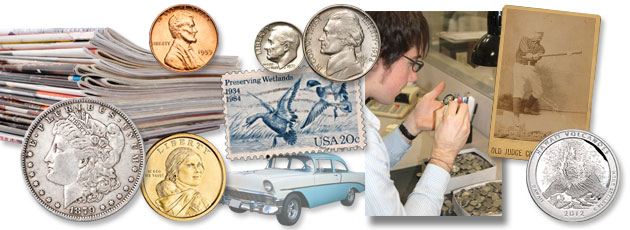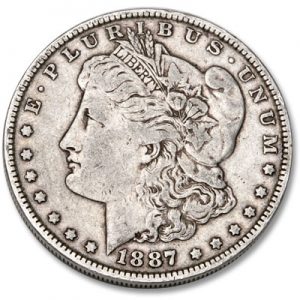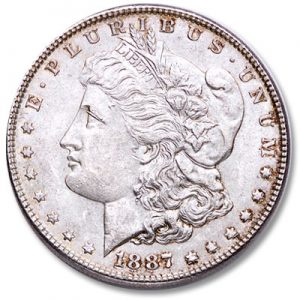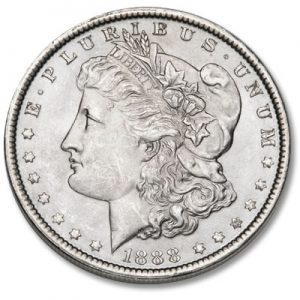Coin Grading 101
 Like nearly all collectibles (antiques, classic cars, comic books, baseball cards, stamps and more), the condition or grade of a coin is a major factor in its value. Any coin’s state of preservation determines how much of the original design is still present to be enjoyed, appreciated… and compared to other examples of the same issue. Here are some basic principals of coin grading:
Like nearly all collectibles (antiques, classic cars, comic books, baseball cards, stamps and more), the condition or grade of a coin is a major factor in its value. Any coin’s state of preservation determines how much of the original design is still present to be enjoyed, appreciated… and compared to other examples of the same issue. Here are some basic principals of coin grading:
The numerical coin grading scale
Coin grading is done on a scale from 1-70, with numerical grades from MS60 to perfect MS70 (MS denotes Mint State) representing “Uncirculated” coins – those that have not experienced hand-to-hand commercial use. Numerical grades below 60 represent “Circulated” coins – which have been individually handled and will display varying amounts of wear. It’s important to distinguish between grade-significant characteristics of Uncirculated and Circulated coins:
-

Very Good (VG 08-11) – Coin will have a fully defined rim and full legends with all the lettering and numerals distinct. Some detail in the design of the coin will begin to show.
Production and distribution blemishes
No two coins leave the mint where they were produced in exactly the same condition. The quality of planchets or coin blanks can vary, and the dies that impress the designs on the planchets can have marks or cracks that show up on the coins. In addition, finished coins can receive contact marks when they drop into bins after striking, when they proceed through a counting machine and when placed in cloth mint bags along with many other coins for storage and transportation to the Federal Reserve bank system.Contact marks received at any stage of the minting process or in transportation and storage are called “bag marks” (though only some actually occur in bags). Coins with these production and distribution marks are still considered Uncirculated if they have never been individually handled. -

Fine (F12) – Moderate wear will be evident. The date will be bold and all letters and legends will be clear. Major elements in the design will show some separation.
Circulation wear and deterioration
When a coin enters circulation and first begins to show signs of wear, only the highest or most raised parts of the design are affected, because they receive contact from handling first. Grading experts can determine whether a coin has circulated or been handled by carefully examining the high spots for changes in color, texture or detail. The highest points will first become slightly rounded or flattened, and the finest details begin to merge together.After more handling, the entire design and surface will show light wear or rub, and original mint luster begins to wear away except in recessed areas. Continued circulation reduces the definition and relief (height) of the entire design and eliminates mint luster. When the protective rim wears away, the entire surface flattens and most details diminish or blend together.
How to get started

Extra Fine (XF40) – All elements in the design will be clearly visible. There may be mint luster evident, especially around the edges of the design. The high points of the design will be slightly worn.
The best way to learn to grade coins is by comparing actual coins with a magnifier to photographs and descriptions of that type in various grade levels. There are a few excellent grading guidebooks with images of each coin type in each grade. Photograde is an economical basic book using this technique. For books with more extensive descriptions of each coin type and grade, see Whitman Publishing’s Grading Coins by Photographs by numismatic expert Q. David Bowers featuring full-color coin images, or this great coin grading guide from NGC’s, David Lange, which outlines grading on 70 U.S. coin types.
Littleton’s staff has the opportunity to compare coins both with illustrated grading guides and actual coin samples of each grade level (see You need more than a magnifier for grading for more about how our graders learn their craft).
Begin with a familiar series

Uncirculated (MS60) – Uncirculated coins exhibit no wear from general circulation. Depending on contact they may have had with other coins and atmospheric conditions during or after coining, blemishes, bag marks and toning may be present. Uncirculated coins may lack luster and still be considered Uncirculated.
You should start with a series or two which are readily available – perhaps Lincoln cents and Washington quarters. Learn the key locations to inspect for wear from handling and the areas where more extensive circulation are detected. As you gain familiarity with grade levels of a coin type, you can practice by examining pieces at coin shops or coin shows in your area. Expand your learning to other types of coins as your time and interest permit.
Coin grading is an art, not a science!
Bear in mind that while generally standardized, coin grading is still a subjective art. As you become proficient with grading, you may or may not agree with the grade listed on someone’s coin holder! To facilitate the exchange of valuable coins, independent grading services including PCGS and NGC certify the authenticity and grade of coins in their custom holders – which protect against harmful environmental conditions.
Important Note: While circulation wear tends to be uniform within coin types, many “bag marks” found on Uncirculated coins are random and vary widely in location and severity. Therefore, the grading of Uncirculated coins at Littleton is entrusted only to our most experienced staff.
Watch this video to discover more about what it takes for a coin to be good enough to be a “Littleton Select.”
Are you in the process of learning the coin grading art? Please share your thoughts and recommendations with other readers.




Are all About Unc coins and Burnished Unc coins (MS60) grade?
Hi Richard, The term “MS60” means “Mint State 60”. It is a coin grade designation for what would be typically called an “Uncirculated” coin. Uncirculated means the coin does not show any wear from normal circulation. The American Numismatic Association came up with a numerical grading scale many years ago, to determine the condition or grade of a circulated or uncirculated coin. That scale goes from 0 to 70, so an uncirculated coin can be graded anywhere from 60 to 70. It is commonly referred to as in “Mint State” –or original mint condition – and is usually combined with the corresponding grade number (i.e. MS60, MS64, MS70, etc).
The term “About Uncirculated” is another grade designation. Its numerical equivalent on the grade scale is 50 to 59. This would be used to describe a coin that has experienced only slight wear from normal circulation. You will often see it abbreviated as “AU50”. A grade of AU50 would be one grade level below MS60.
The term “Burnished” is a fancy word for polished. You’ve probably heard it a lot lately with the American Eagle Silver Dollars. Since 2006 the US Mint has been producing a version of the Silver Eagle on what is referred to as a “burnished planchet”. A planchet is the metal disk used to make a coin. In the case of the burnished Silver Eagles, the Mint polishes the coin blanks before stamping them. Since the American Silver Eagles are not circulated, they should be in their original mint state so it’s likely they would be graded between MS60 and MS70.
I hope this info is helpful. Have a great day! -Rick